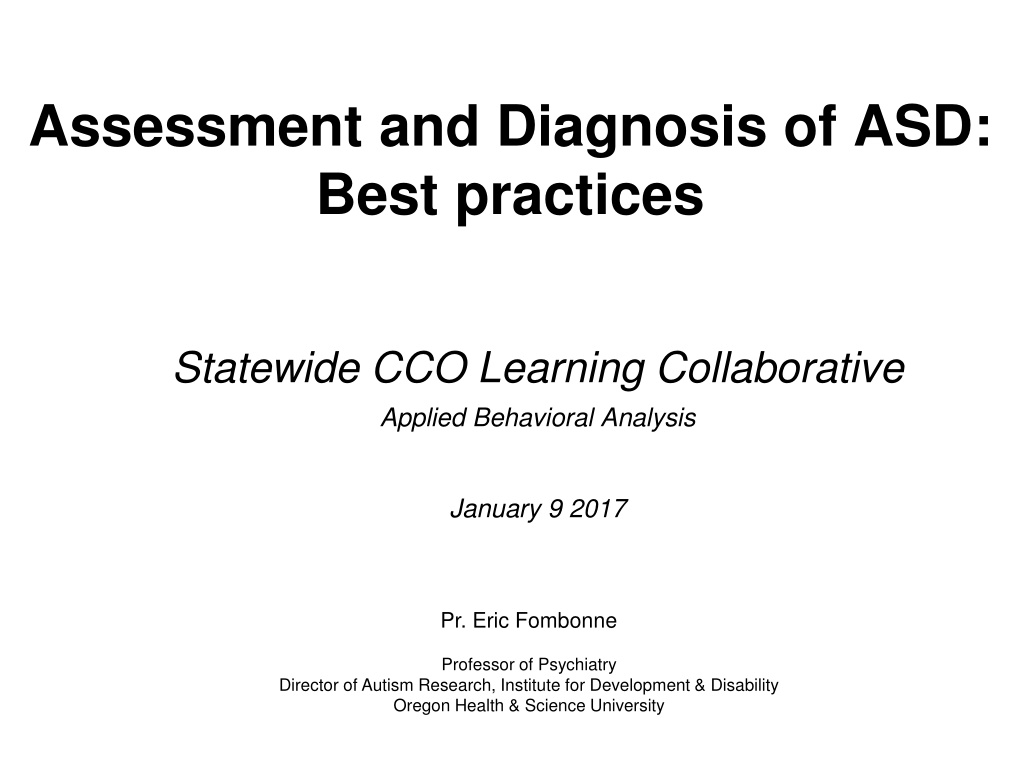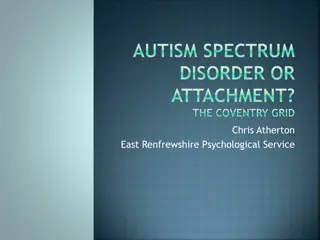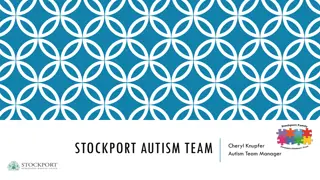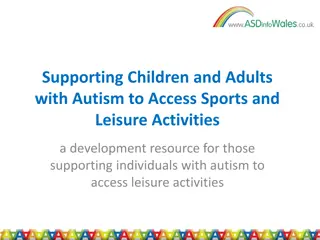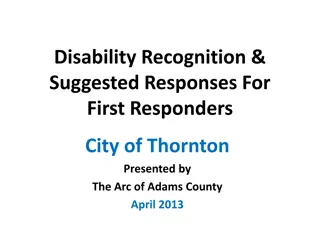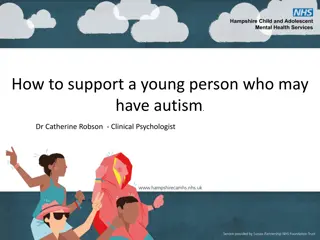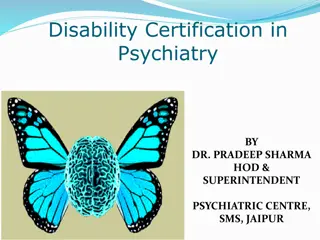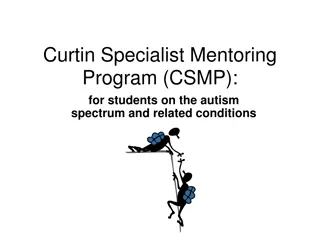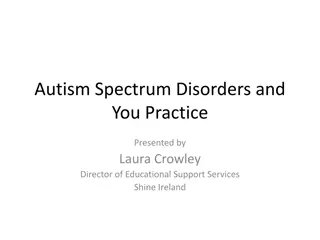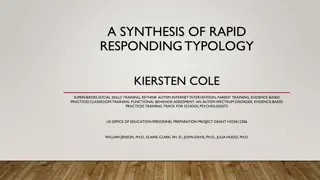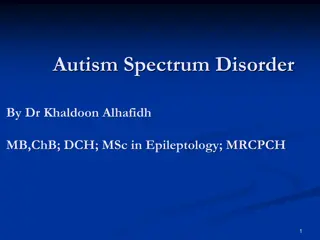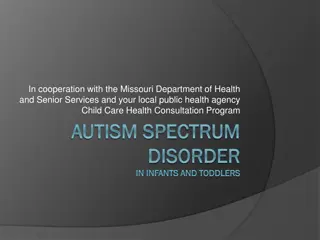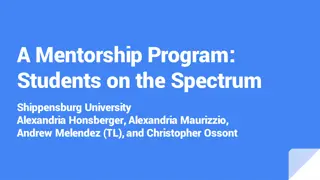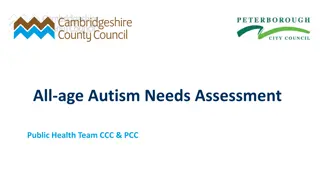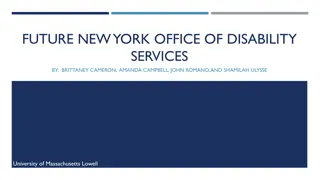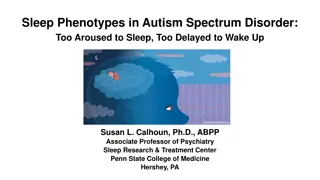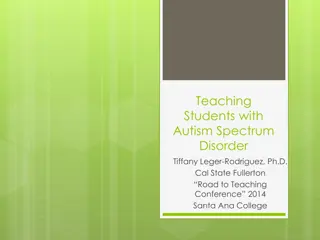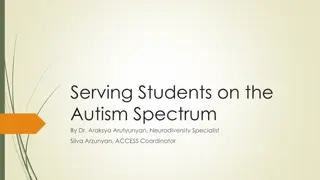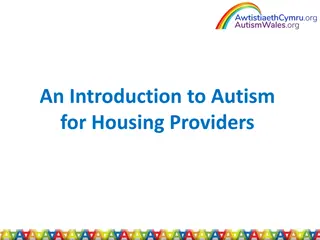Understanding Autism Spectrum Disorder: Assessment, Diagnosis, and Characteristics
This content delves into the assessment and diagnosis of Autism Spectrum Disorder (ASD) with a focus on early markers, DSM-5 criteria, language/communication abnormalities, social interaction abnormalities, and repetitive behaviors/unusual interests. It provides a comprehensive overview of the key aspects to consider when evaluating individuals for ASD, including developmental trajectories, symptom criteria, and behavioral characteristics commonly observed in those with ASD.
- Autism Spectrum Disorder
- Assessment
- Diagnosis
- Early Markers
- DSM-5 Criteria
- Communication Abnormalities
Download Presentation

Please find below an Image/Link to download the presentation.
The content on the website is provided AS IS for your information and personal use only. It may not be sold, licensed, or shared on other websites without obtaining consent from the author. Download presentation by click this link. If you encounter any issues during the download, it is possible that the publisher has removed the file from their server.
E N D
Presentation Transcript
Assessment and Diagnosis of ASD: Best practices Statewide CCO Learning Collaborative Applied Behavioral Analysis January 9 2017 Pr. Eric Fombonne Professor of Psychiatry Director of Autism Research, Institute for Development & Disability Oregon Health & Science University
Early markers: Developmental trajectories in ASD 6 12 18 24 age in months normal fluctuating skill acquisition childhood disintegrative disorder early onset regression
DSM 5 criteria for Autism Spectrum Disorder A. Persistent deficits in social communication and social interaction across contexts, not accounted for by general developmental delays, and manifest by all 3 of the following: 1. Deficits in socio-emotional reciprocity 2. Deficits in nonverbal communicative behaviours used for social interaction 3. Deficit in developing and maintaining relationships B. Restricted, repetitive patterns of behaviour, interests, or activities as manifested by at least 2 of the following: 1. Stereotyped or repetitive speech, motor movements, or use of objects 2. Excessive adherence to routines, ritualized patterns of verbal or nonverbal behaviour, or excessive resistance to change 3. Highly restricted, fixated interests that are abnormal in intensity or focus 4. Hyper- or hypo-reactivity to sensory input or unusual interests in sensory aspects of environment C. Symptoms must be present in early childhood (but may not become fully manifest until social demands exceed limited capacities D. Symptoms together limit and impair everyday functioning Must meet A, B, C and D, currently or by history
Language/communication abnormalities No babbling, language delay No compensation by alternate modes of communication No pointing (protodeclarative vs protoimperative) No gestures(nodding, shaking, waving bye-bye, etc..) Receptive language Pronominal reversal Neologisms, idiosyncratic sentences Conversation abnormalities Alteration of the pragmatic aspects Literal understanding
Social interaction abnormalities Poor eye gaze and social smiling No social orientation, does not respond to name Atypical greeting behaviors No or infrequent affectionate behaviors No social play No offering/seeking comfort Reduced shared enjoyement Reduced facial and affect expressions Difficulty in emotional recognition Inappropriate behaviors/remarks with strangers Lack of friendships, loner
Repetitive behaviors/Unusual interests Hand and finger mannerisms Unusual sensory reactions Unusual attachment to objects (metal objects, ) Non functional use of objects/toys (lining up, ) Lack of imagination Obsessive behaviors, rituals Resistance to change Insistance on sameness Rigid, inflexible routines Odd pursuits Circumscribed interests
Challenges in the diagnostic process Phenotypic heterogeneity: Same age children with the same diagnosis look very different Child with ASD looks very different at different ages Global development level may or not be delayed Language may or not be delayed Parents caregivers may or not be " good" informants Variable knowledge of typical normal development Spontaneous compensatory behaviors masking child deficits Familial/cultural dynamics and interpretations Oversimplistic explanations: child is misbehaving, or anxious/timid, parenting seems the problem, other detrimental interpretations ,
Rationale for using standardized diagnostic interviews Clinicians use idiosyncratic and inconsistent approaches in coverage in weighing each symptom in combining symptoms in diagnoses Reliability (agreement between clinicians) is low unless they use standardized diagnostic techniques Need for structure and standardization to avoid illusory correlations , confirmatory bias, to organize coverage, ways of evaluating symptoms, combining symptoms into diagnoses, resolving discrepancies Can be achieved by existing interviews or standardization of the clinical approach
ASD evaluation tools Diagnostic check-lists: Childhood Autism rating Scale (CARS), etc.. Standardized diagnostic tools: ADI-R: Autism Diagnostic Interview-Revised (parent/caregiver interview; ~ 2 hours) ADOS-G: Autism Diagnostic Observational Schedule-Generic, ADOS-2 (direct child observation; 30-45 minutes) Others tools: DISCO, 3Di, STAT, ASI Administration requires clinical background and specific ad hoc training Symptom check-lists Social Reciprocity Scale (SRS; parent- or teacher-completed) Autism Screening Questionnaire (ASQ), GARS,.. Screening tools for toddlers: ESAT, M-CHAT Other screening tools: SCQ, etc..
Diagnostic evaluation - 1 There is no biological test or marker for ASD Diagnostic principles: Require multidisciplinary team: Peds/Psychiatry/Neuro + OT, Audiology, SLT, Psychology Specific diagnostic tools are preferred (ADOS, ADI) Combination of multi-informant/data sources is necessary Usual steps are: Parent/caregiver interview (ADI) Direct observation of child (ADOS) Review of medical records and of day care/teacher reports Medical history and examination Other assessments are required to evaluate functional impairment and treatment needs: OT, SLP, audiology intellectual assessment and adaptive behavior (psychology)
Diagnostic evaluation - 2 Integration of data from different sources is necessary, including resolving discrepancies Mechanical reliance on scores ( above the cut-off ) is discouraged Differential diagnosis: Mental retardation & developmental delays Anxiety disorder , OCD Severe ADHD Language disorders including Semantic pragmatic disorder Schizoid disorder & Sx spectrum Subspecialty referrals must be considered when appropriate Feed-back to parents is a crucial piece
ASD Medical Assessment Audiology All children with developmental delays, especially social and language Requires modifications of traditional test techniques and environments (e.g., operant test procedures) Electrophysiologic procedures are useful for estimating hearing sensitivity and for examining middle ear, cochlear, and VIIIth nerve or auditory brainstem pathway integrity Evoked otoacoustic emissions are useful for examining cochlear (sensory) function, and is a frequency-specific, as well as a time- and cost-efficient procedure Frequency-specific auditory brainstem response (ABR) is the single most useful electrophysiologic procedure for use in estimating hearing thresholds, and has been demonstrated to be highly correlated with behavioral hearing thresholds in children who hear normally and in children who have sensorineural hearing loss. Committee on Infant Hearing of the American Speech Language Hearing Association
ASD Medical Assessment Genetic Testing For all patients Chromosomal microarray: oligonucleotide array-comparative genomic hybridization (CGH) or single-nucleotide polymorphism array Conditional on findings Deoxyribonucleic acid (DNA) testing for fragile X: In males: to be performed routinely In females: if indicators present (e.g., family history and phenotype) Methyl-CPG-binding protein 2 (MECP2) sequencing to be performed: for all females with autism spectrum disorders (ASDs) MECP2 duplication testing in males, if phenotype is suggestive Phosphatase and tensin homolog (PTEN) testing only if the head circumference is >2.5 standard deviation (SD) above the mean American College of Medical Genetics and Genomics 2013
ASD Medical Assessment Other laboratory tests Metabolic disorders in ASDs represent low incidence yet high impact. No consensus on what level of testing should be recommended Consider if: lethargy, cyclic vomiting, early onset seizures, dysmorphic features, newborn screening not done American College of Medical Genetics and the Society for Inherited Metabolic Disorders in 2009 Mitochondrial testing Electrolyte disturbances, anemia, lethargy, multisystem perturbations, regression, cyclic vomiting, dermatologic changes, poor growth, seizures, hypo-/dystonia, gastrointestinal dysfunction, microcephaly Lead testing Children with developmental delays, including Autism, even without frank pica, should be screened for lead poisoning No evidence: hair analysis, celiac antibodies, allergy testing (food allergies for gluten, casein, candida, and other molds), immunologic or neurochemical abnormalities, micronutrients such as vitamin levels, intestinal permeability studies, stool analysis, urinary peptides, mitochondrial disorders (including lactate and pyruvate), thyroid function tests, or erythrocyte glutathione peroxidase studies National Center for Environmental Health of CDC, 1997
ASD Medical Assessment Brain Imaging & EEG Neuroimaging: not recommended routinely American Academy of Neurology Practice Parameter,Filipek 2000 More recently, brain MRI recommended when: Abnormal neurologic examination/pre-existing or known Neurologic Disorder (26%) Headaches (26%) Seizures (22%) Cooper et al., 2016 EEG: not recommended routinely adequate sleep-deprived EEG with appropriate sampling of slow wave sleep recommended if: clinical seizures or suspicion of subclinical seizures history of regression (clinically significant loss of social and communicative function) at any age, but especially in toddlers and preschoolers American Academy of Neurology Practice Parameter,Filipek 2000
Co-occurring medical conditions Common childhood diseases occur in child with ASD as in any other child Medical issues more frequently occurring in ASD Seizures: early or late (puberty) onset Gastro-intestinal problems: constipation 20% , chronic diarrhea 19% Selective eaters Obesity Sleep disturbances: 40-80% Risk of overshadowing
Psychiatric disorders occurring more frequently in ASD Disorder Prevalence % In addition: Any disorder 70 Disruptive problems: SIB, aggression, property destruction Tics, Tourette Syndrome: increased Gender Dysphoria: increased Schizophrenia and bipolar disorder can occur in ASD individuals but the risk is not raised (except in some forms of syndromic autism such as 22q, 16q) >= 2 disorders 41 Social anxiety 29 ADHD 28 Oppositional Defiant Disorder 28 Obsessive Compulsive Disorder 17 Source: SNAP study, London Simonoff et al. 2008
Common misconceptions Diagnosis cannot be done before age 3. Diagnosis requires the full battery ADI+ADOS+ other assessments. An ADOS test is sufficient to the diagnosis. When a child has Fragile X (or Down s or TS or any known genetic disorder), he cannot be diagnosed with ASD.
Common misconceptions contd Because of its early onset, ASD cannot be newly diagnosed in adult life. An autistic syndrome in a child who is adopted, in foster care, or raised in a context of maternal deprivation, means his diagnosis should be Reactive attachment disorder . If parent endorses descriptions read aloud from the DSM, the child has surely an ASD. If 2 siblings are affected with ASD, they will show the same degree of severity.
